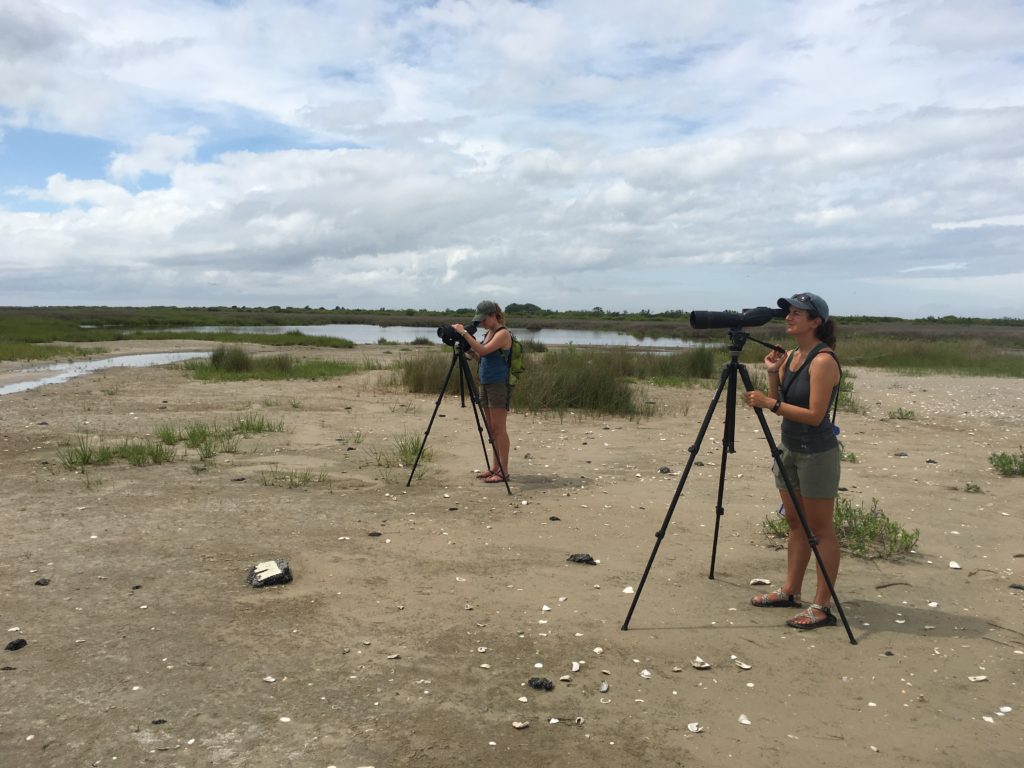Guest post be researcher Chelsea Weithman
Linked paper: Growth of two Atlantic Coast Piping Plover populations by C.E. Weithman, S.G. Robinson, K.L. Hunt, J. Altman, H.A. Bellman, A.L. DeRose-Wilson, K.M. Walker, J.D. Fraser, S.M. Karpanty, and D.H. Catlin, The Condor: Ornithological Applications.
The beach: the sun, the sand, the water. It’s a wonderful place to be in the summer, whether you’re a shorebird or a human. Beach-nesting shorebird species increasingly have to share the shore with recreationists and human development, and many species of shorebird have been declining as a result. One beach-nesting specialist is the Piping Plover, which nests on sandy beaches along the North American Atlantic Coast, the Great Lakes, and riverine and alkali lakes of the Great Plains. To aid the recovery of the federally threatened Atlantic Coast Piping Plover, wildlife managers try to reduce disturbance and predation risks on its breeding grounds so that the plovers can successfully raise more fledglings. The hope is that increasing the number of fledglings will lead to population growth and, eventually, species recovery.
As part of my graduate work, my coauthors and I studied the population dynamics of Piping Plovers at Cape Hatteras National Seashore and other parts of the North Carolina Outer Banks. North Carolina is a particularly interesting place for these little shorebirds, because it hosts plovers throughout the year. Plovers have been studied in other parts of their range for decades, but the North Carolina population has not received as much attention. Would this breeding population be any different?

Based on analysis of long-term reported population estimates and reproductive output, this population—along with others in Virginia, Maryland, and Delaware—was thought to potentially reap some benefit from its position in the southern end of the breeding range. Particularly, these plovers were hypothesized to have higher survival rates, since they don’t have to migrate as far to reach their breeding ground as their brethren in the northeastern U.S. and Canada do. Perhaps, then, these southern populations may not need to produce as many young each year to maintain their population. If true, this difference in survival rates could have implications for how we think about and evaluate the recovery of this species. We set out to examine this hypothesis by comparing two populations in different areas of the breeding range: one population on Fire Island, New York, and one in North Carolina.
Contrary to our expectations, we found that plovers in North Carolina and New York have very similar survival rates and presumably need to produce similar numbers of chicks per breeding pair to maintain their populations. The New York population has grown considerably over the decades, especially after Hurricane Sandy created vast new areas of ideal habitat in 2012. The North Carolina population, on the other hand, has not met the estimated reproductive rate needed to maintain their population for more than 30 years. Based on this result, our burning question was, how are there still plovers in North Carolina at all?
We believe that the population in North Carolina is being sustained by a constant influx of immigrants—instead of chicks growing up and taking the place of their parents, immigrants from outside the population are keeping their numbers up. However, we don’t yet know where these immigrants are coming from or what their departure means for their original populations’ growth prospects. We’re continuing to study this phenomenon in hopes of better understanding how and why plovers choose to disperse and join other populations. This is important for the bigger picture of plover conservation, since so much time, energy, and money are dedicated to the important work of improving reproductive success. If other factors such as immigration are key components of a population’s health, then management strategies may need to be developed to support them, too.
